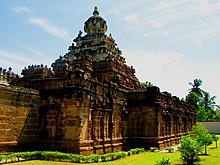
The Ashtabujakaram or Ashtabuja Perumal Temple located in Kanchipuram in the South Indian state of Tamil Nadu, is dedicated to the Hindu god Vishnu. Constructed in the Dravidian style of architecture, the temple is glorified in the Nalayira Divya Prabandham, the early medieval Tamil canon of the Alvar saints from the 6th–9th centuries CE. It is one of the 108 Divya Desams dedicated to Vishnu, who is worshipped as Ashta Bhuja Perumal and his consort Lakshmi as Alamelumangai.

The Pundarikakshan Perumal Temple or Thiruvellarai Temple in Thiruvellarai,a a village in the outskirts of Tiruchirappalli in the South Indian state of Tamil Nadu, is dedicated to the Hindu god Vishnu. Constructed in the Dravidian style of architecture, the temple is glorified in the Naalayira Divya Prabandham, the early medieval Tamil canon of the Alvar saints from the 6th–9th centuries CE. It is one of the 108 Divya Desams dedicated to Vishnu, who is worshipped as Pundarikakshan and his consort Lakshmi as Pankajavalli.

Appakkudathaan Perumal Temple or Thirupper Nagar, is a Perumal temple located in Koviladi, a village 10 miles (16 km) from Tiruchirapalli, Tamil Nadu, India. It is dedicated to Vishnu and is one of the Divya Desams—the 108 temples of Vishnu revered in Nalayira Divya Prabandham by the 12 poet saints or Alvars. This temple is located along the banks of the Cauvery River and is one of the five Pancharanga Kshetrams located on the banks of the Cauvery River.

Tiruvekkaa Temple or Yathothkari Perumal Temple is a Hindu temple located in Kanchipuram in the South Indian state of Tamil Nadu and dedicated to the Hindu god Vishnu. Constructed in the Dravidian style of architecture, the temple is glorified in the Naalayira Divya Prabandham, the early medieval Tamil canon of the Alvar saints from the 6th–9th centuries CE. It is one of the 108 Divya Desams dedicated to Vishnu, who is worshipped as Yathothkari Perumal, and his consort Lakshmi as Komalavalli.

The Deepaprakasa Perumal Temple, also referred to as Tiruththanka, and Tooppul, is located in Kanchipuram in the South Indian state of Tamil Nadu, is a temple dedicated to the Hindu god Vishnu. Constructed in the Dravidian style of architecture, the temple is glorified in the Naalayira Divya Prabandham, the early medieval Tamil canon of the Alvar saints from the 6th–9th centuries CE. It is one of the 108 Divya Desams dedicated to Vishnu, who is worshipped as Deepaprakasar, and his consort Lakshmi as Maragathavalli.

Sthalasayana Perumal Temple is a Hindu temple dedicated to the god Vishnu located near Kollumangudi, Tamil Nadu, India. It is located 2 km away from Kollumangudi, 40 km away from Kumbakonam and 10 km from Karaikal. Constructed in the Dravidian style of architecture, the temple is glorified in the Nalayira Divya Prabandham, the early medieval Tamil canon of the Alvar saints from the 6th–9th centuries CE. It is one of the 108 Divya Desams dedicated to Vishnu, who is worshipped as Sthalasayana Perumal and his consort Lakshmi as Thirumagal Nachiyar. A granite wall surrounds the temple, enclosing all the shrines. There is a four-tiered rajagopuram, the temple's gateway tower, in the temple.

The Jagad Rakshaka Perumal Temple or Thirukoodalur in Vadakurangaduthurai, a village in the outskirts of Kumbakonam in the South Indian state of Tamil Nadu, is dedicated to the Hindu god Vishnu. Constructed in the Dravidian style of architecture, the temple is glorified in the Nalayira Divya Prabandham, the early medieval Tamil canon of the Alvar saints from the 6th–9th centuries CE. It is one of the 108 Divya Desams dedicated to Vishnu, who is worshipped as Jakath Rakshaka and his consort Lakshmi as Pushpavalli.
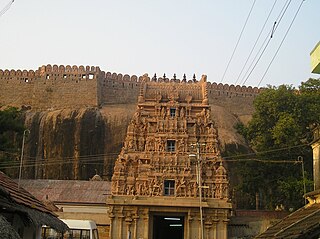
Sathyamurthi Perumal Temple in Thirumayam, a panchayat town in the South Indian state of Tamil Nadu, is dedicated to the Hindu god Vishnu. Constructed in the Dravidian style of architecture, the temple is glorified in the Nalayira Divya Prabandham, the early medieval Tamil canon of the Alvar saints from the 6th–9th centuries CE. It is one of the 108 Divya Desams dedicated to Vishnu, who is worshipped as Sathyamurthi Perumal and his consort Lakshmi as Ujeevana Thayar.

Ulagalandha Perumal Temple is a temple dedicated to Vishnu located in Kanchipuram, Tamil Nadu, India. Constructed in the Dravidian style of architecture, the temple is glorified in the Naalayira Divya Prabandham, the early medieval Tamil canon of the Alvar saints from the 6th through 9th centuries CE. It is one of the 108 Divya Desams dedicated to Vishnu, who is worshipped as Ulagalantha Perumal, and his consort Lakshmi as Amuthavalli. The temple is believed to have been built by the Pallavas, with later contributions from the medieval Cholas, Vijayanagara kings, and Madurai Nayaks.
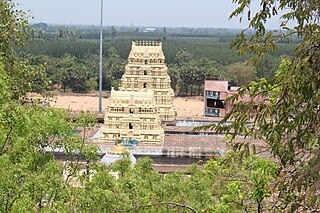
Devanatha Hemabhujavalli Temple is a Hindu temple in Thiruvanthipuram, a village in the outskirts of Cuddalore in the South Indian state of Tamil Nadu, dedicated to the god Vishnu and goddess Lakshmi. Constructed in the Dravidian style of architecture, the temple is glorified in the Nalayira Divya Prabandham, the early medieval Tamil canon of the Alvar saints from the 6th–9th centuries CE. It is one of the 108 Divya Desams dedicated to Vishnu, who is worshipped as Devanatha and Lakshmi as Hemabhujavalli. Though the presiding deity is Devanatha and Hemabhujavalli, the temple is known for Hayagriva, the ninth avatara of Vishnu in the Dashavatara of Vishnu and a god of knowledge. The temple is the only historical temple in South India to have a shrine of Hayagriva on hilltop.

Tirupavalavannam or Pavalavanam temple located in Kanchipuram in the South Indian state of Tamil Nadu, is dedicated to the Hindu god Vishnu. Constructed in the Dravidian style of architecture, the temple is glorified in the Nalayira Divya Prabandham, the early medieval Tamil canon of the Alvar saints from the 6th–9th centuries CE. It is one of the 108 Divya Desams dedicated to Vishnu, who is worshipped as Pavalavannar Perumal and his consort Lakshmi as Pavalavalli.

Pandavatutar Perumal Temple or Thirupadagam located in Kanchipuram in the South Indian state of Tamil Nadu, is dedicated to the Hindu god Krishna, an avatar of the god Vishnu. Constructed in the Dravidian style of architecture, the temple is extolled in the Nalayira Divya Prabandham, the early medieval Tamil canon of the Alvar saints from the 6th–9th centuries CE. It is one of the 108 Divya Desams dedicated to Vishnu, who is worshipped as Pandava Tutar Perumal (Krishna) and his consort Lakshmi (Rukmini.)
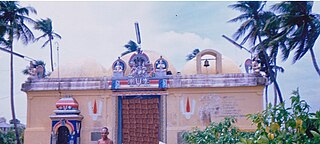
Thiruvaikunda Vinnagaram or Vaikunta Nathan Perumal Temple is dedicated to Hindu god Vishnu located in Tirunangur, a village in the outskirts of Sirkazhi in the South Indian state of Tamil Nadu. Constructed in the Dravidian style of architecture, the temple is glorified in the Nalayira Divya Prabandham, the early medieval Tamil canon of the Alvar saints from the 6th–9th centuries CE. It is one of the 108 Divya Desams dedicated to Vishnu, who is worshipped as Vaikuntanathan and his consort Lakshmi as Vaikuntavalli.

Parimala Ranganathar Perumal Temples or Tiruindaloor is a Hindu temple dedicated to Vishnu, located in Thiruvilandur of Mayiladuthurai, a town in the South Indian state of Tamil Nadu. It is one of the Divya Desams, the 108 temples of Vishnu revered in Nalayira Divya Prabandham by the 12 poet saints, or the Alvars. This temple is along Kaveri and is one of the Pancharanga Kshetrams.
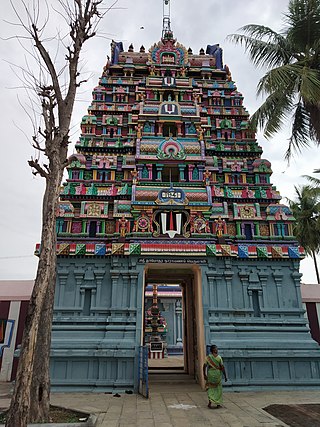
The Loganatha Perumal Temple is a Hindu temple dedicated to Vishnu located 2 km away from Sikkal, Tamil Nadu, India on the Tiruvarur-Nagapatnam highway. Constructed in the Dravidian style of architecture, the temple is glorified in the Nalayira Divya Prabandham, the early medieval Tamil canon of the Alvar saints from the 6th–9th centuries CE. It is one of the 108 Divya Desams dedicated to Vishnu, who is worshiped as Loganatha Perumal and his consort Lakshmi as Loganayagi.

The Gajendra Varadha Perumal Temple in Thirukkavithalam, a village in the outskirts of Papanasam in the South Indian state of Tamil Nadu, is dedicated to the Hindu god Vishnu. Constructed in the Dravidian style of architecture, the temple is glorified in the Nalayira Divya Prabandham, the early medieval Tamil canon of the Alvar saints from the 6th–9th centuries CE. It is one of the 108 Divya Desams dedicated to Vishnu, who is worshipped as Gajendra Varadha Perumal and his consort Lakshmi as Ramamanivalli. The temple is one of the five Pancha-Kannan temples, where Krishna, an avatar of Vishnu is given prominence over the presiding deity.
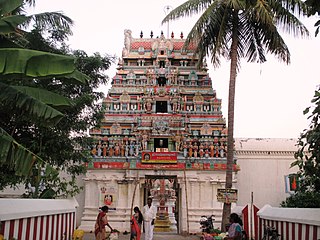
Nathan Kovil or Thiru Nandipura Vinnagaram Temple in Nathan Kovil, a village in the outskirts of Kumbakonam in the South Indian state of Tamil Nadu, is dedicated to the Hindu god Vishnu. Constructed in the Dravidian style of architecture, the temple is glorified in the Nalayira Divya Prabandham, the early medieval Tamil canon of the Alvar saints from the 6th–9th centuries CE. It is one of the 108 Divya Desams dedicated to Vishnu, who is worshipped as Jagannathan and his consort Lakshmi as Shenbagavalli.

The Thirupuliyangudi Perumal Temple is one of the Nava Tirupati, the nine Hindu temples dedicated to Vishnu located in Tiruchendur-Tirunelveli route, Tamil Nadu, India in the banks of Thamiraparani river, in the South Indian state of Tamil Nadu. It is dedicated to the Hindu god Vishnu who is worshipped as Bhumipalar and Lakshmi as Pulingudivalli. It is located 22 km from Tirunelveli. Constructed in the Dravidian style of architecture, the temple is glorified in the Nalayira Divya Prabandham, the early medieval Tamil canon of the Alvar saints from the 6th–9th centuries CE. It is one of the 108 Divya Desams dedicated to Vishnu. The temple is also classified as a Nava Tirupati, the nine temples revered by Nammalvar located in the banks of Tamiraparani river. The temple is one of the Navagraha temples in the region, associated with Budha.
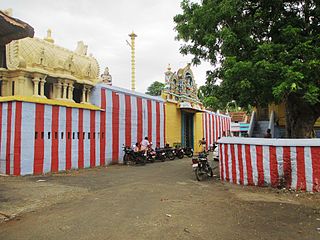
The Thiruvazhmarban Temple, also known as Sri Kuralappa Perumal Temple in Thiruppathisaram, a village in Kanyakumari district in the South Indian state of Tamil Nadu, is dedicated to the Hindu god Vishnu. Thiruvazhmarban Temple is located about 5 km far, north-easterly to Nagercoil, 20 km far, north-westerly to Kanyakumari and 45 km south-west of Nanguneri Divya Desam. Constructed in the Dravidian style of architecture, the temple is glorified in the Nalayira Divya Prabandham, the early medieval Tamil canon of the Alvar saints from the 6th–9th centuries CE. It is one of the 108 Divya Desams of malayala nadu divyadesham dedicated to Vishnu, who is worshipped as Thiruvazhmarban and his consort Lakshmi as Kamalavalli in kerala tantric traditions. The oldest inscription in the temple is from 1139 CE indicating gifts to the temple. A granite wall surrounds the temple, enclosing all its shrines. The temple tank is located opposite to the temple, outside the main entrance.

Nilathingal Thundam Perumal temple is a Hindu temple dedicated to Vishnu, located in Kanchipuram in the state of Tamil Nadu, India. The temple is located in a shrine in Ekambareswarar Temple, the largest temple in the town of Kanchipuram, located in the northern part of the town. The temple gopuram is 59 m tall, which is one of the tallest gopurams in India.
